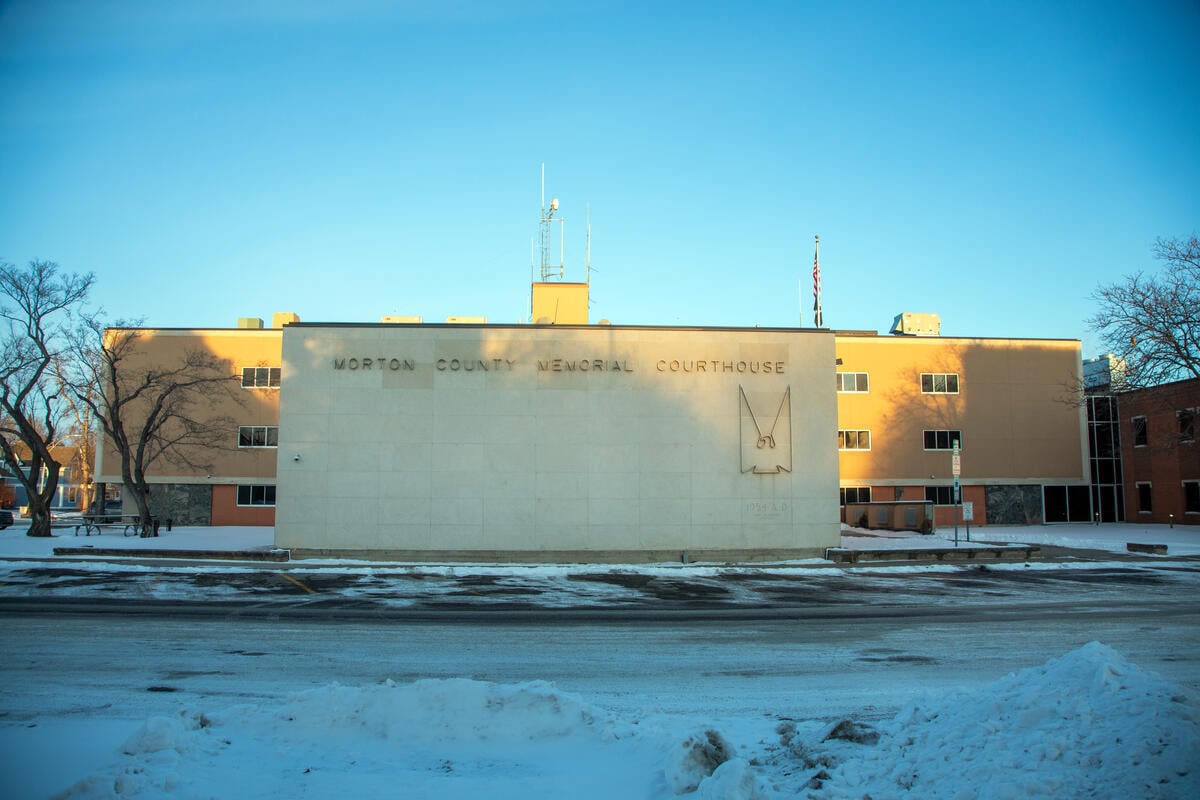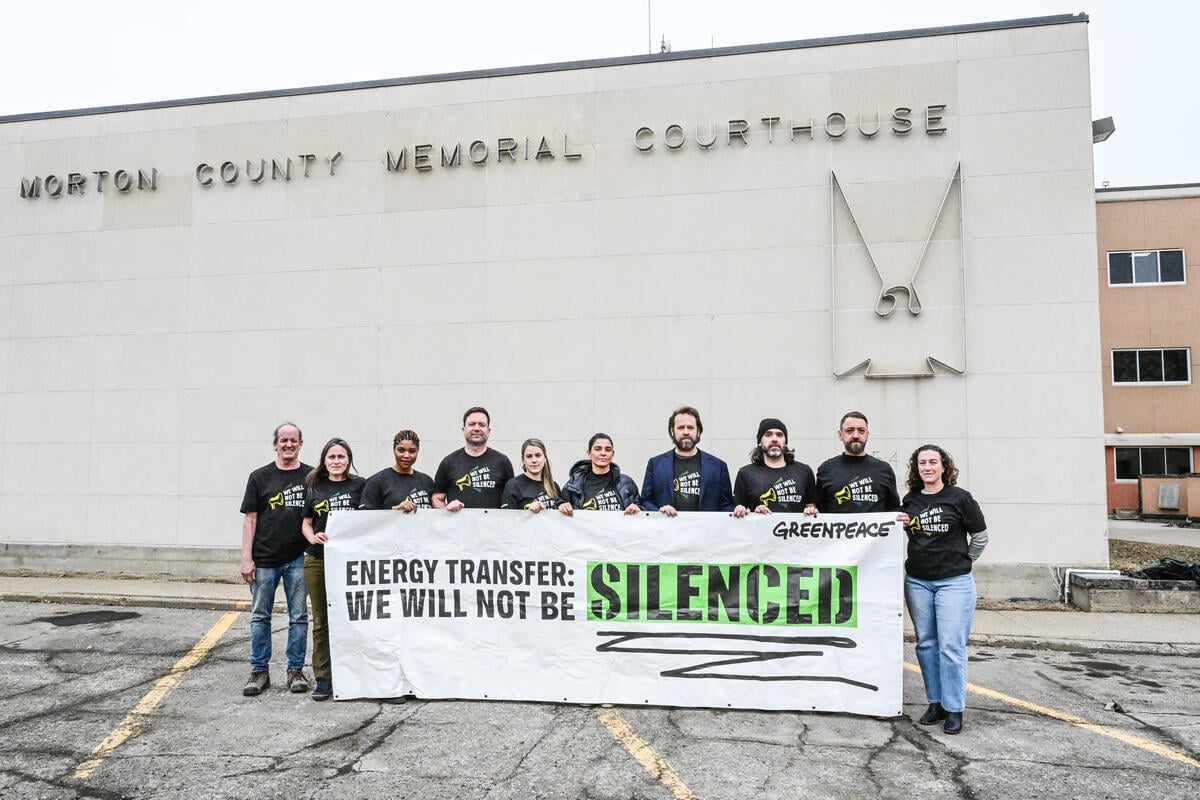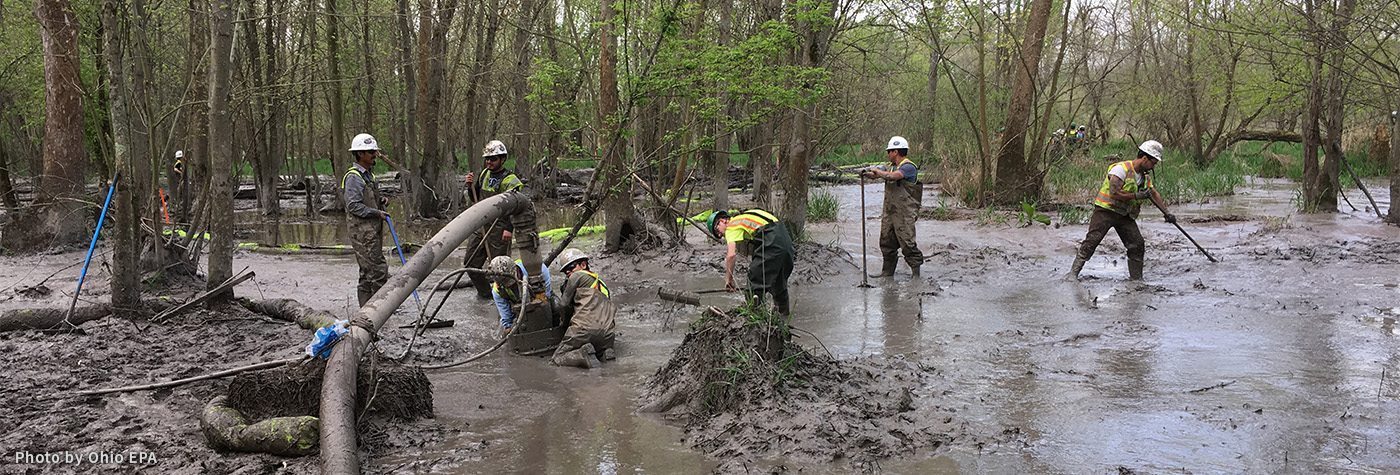


Table of contents
Summary Results
- From 2002 to the end of 2017, ETP, Sunoco and their subsidiaries and joint ventures reported 527 hazardous liquids pipeline incidents to federal regulators — approximately one incident from existing facilities every eleven days.
- Those incidents, reported by the Pipeline Hazardous Material Safety Administration (PHMSA), released a total of 87,273 barrels (3.6 million gallons, or about five-and-a-half Olympic-sized swimming pools) of hazardous liquids, including 66,515 barrels (2.8 million gallons) of crude oil.
- In addition, state regulatory agencies have documented spills totaling at least 2.4 million gallons of drilling fluids, sediment and industrial waste during the construction of just two ETP pipelines in Michigan, Ohio, Pennsylvania and West Virginia.
- Crude oil spills made up 408 of the PHMSA incidents, along with 92 refined petroleum product spills and 27 highly-volatile liquid (HVL), flammable or toxic spills.
- Of the hazardous liquid spills from existing facilities 101 incidents were of 50 barrels or more (2100 gallons, a volume which is considered “significant” by the federal regulator).
- 67 of the hazardous liquid incidents were reported to have contaminated water, of which 18 incidents contaminated groundwater.
- These spills caused an estimated $115 million in property damage, and led to 106 Notices of Probable Violations, and $5,675,870 million in penalties from PHMSA alone.
- The largest spills in the PHMSA database were crude oil spills of 436,000, 361,000, 290,000, 189,000, 153,000, 143,000, 139,000, and 105,000 gallons, and 2 HVL spills of 168,000 and 121,000 gallons.
- In addition, state agencies and the Federal Energy Regulatory Commission (FERC) have issued over 100 notices of violation and/or non-compliance for the construction of the Rover and Mariner pipelines. In 2017-18 alone, ETP and Sunoco were issued six stop work orders by state agencies and FERC because their construction operations violated permit requirements and/or rules and regulations designed to protect streams, rivers, wetlands, drinking water, historic sites and public safety.
- The Dakota Access Pipeline (DAPL) and its southern component only began operations in 2017, but have already reported 7 incidents.
- Assuming the U.S. system-wide rate for significant crude oil spills of 0.001 per year per mile, we estimate that the Bakken Pipeline would suffer 96 significant spills and the Bayou Bridge Pipeline would suffer eight significant spills, during a 50-year nominal lifetime.
- There is no failsafe way to transport fossil fuels and pipeline spills remain a direct and seemingly unavoidable consequence of oil and gas activity.
- Rapid transition to renewable energy could dramatically reduce spills from pipelines and pollution of drinking water sources.
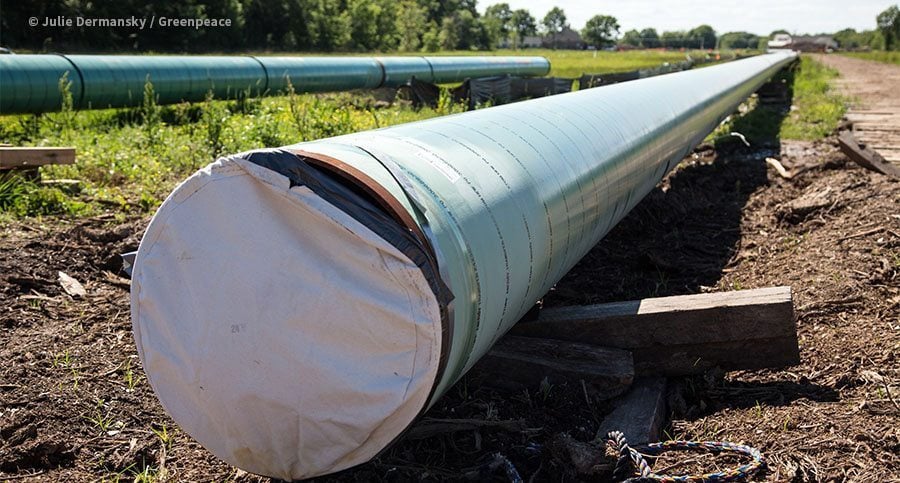
Energy Transfer Partners and Sunoco Have a History of Spills from Existing Pipelines
Energy Transfer Partners and its complex network of subsidiaries and joint ventures owns one of the nation’s largest networks of natural gas, crude oil and petroleum products pipelines. Data collected from the U.S. Pipeline and Hazardous Materials Safety Administration (PHMSA) shows that the ETP family of hazardous liquids pipelines experienced 527 incidents from 2002 to the end of 2017, spilling ~87,000 barrels, and causing an estimated $115 million in property damage.
We have mapped these incidents, spread across numerous states and regions in the U.S. where ETP operates.[1]
Company history and structure
Energy Transfer Partners, L.P. (ETP) was founded in 1995 by Ray Davis and Kelcy Warren (who is still its current Chairman and CEO) and became a publicly traded partnership in 2004. ETP is in turn controlled by a master limited partnership called Energy Transfer Equity (ETE), of which Warren is also the Chairman.[2]
The company’s national profile was fairly small until the massive grassroots resistance to its Dakota Access Pipeline (DAPL) led by the Standing Rock Sioux Tribe was splashed across the headlines in 2016. That same year, Warren donated $100,000 to Donald Trump’s presidential campaign[3] and later cut a check for $250,000 for Trump’s inauguration.[4] Trump made the approval of DAPL’s final permits one of his administration’s first priorities upon becoming U.S. President.[5]
ETP’s corporate structure is famously complicated.[6] In October 2012, ETP merged with Sunoco, Inc.,[7] a fuel refining, distribution and retail company that had been founded in 1886.[8] Prior to the merger, ETP and ETE were primarily focused on the natural gas sector, and the merger with Sunoco allowed them to diversify into “liquids” pipelines due to Sunoco’s significant crude oil and refined petroleum product assets.[9] Part of this business operated as Sunoco Logistics Partners (SXL) until it fully merged with ETP in April 2017.[10] Sunoco LP (SUN) continues to exist as a downstream distributor of motor fuel.
Currently three of these entities — ETP, ETE and SUN — are publicly traded on the New York Stock Exchange. The company also boasts a number of subsidiaries and joint ventures as part of its “family” which we have attempted to reflect in this report. Including both liquids and natural gas, ETP operates more than 71,000 miles of pipelines in the U.S. — nearly long enough to encircle the earth three times.[11]
Leaky pipes
The PHMSA database of all U.S. hazardous liquids pipeline incidents from 2002 to present contains 6,102 reported incidents.[12] Of those incidents, 527 were associated with ETP, Sunoco, or one of their subsidiaries or joint ventures[13] — a rate of one incident occurring approximately every eleven days. These 527 incidents released a total of 87,273 barrels of hazardous liquids, of which 66,515 barrels were crude oil, and led to over $115 million in property damages according to PHMSA’s records. Of the total volume spilled, 36,862 barrels (42%) were never recovered by the company. Since 2002, spills from ETP, Sunoco and subsidiaries led to proposed penalties of $5,675,870.[14]
Other reports have noted the company’s poor safety reputation,[15][16] and have analyzed PHMSA data to conclude that ETP and Sunoco’s pipeline network is among the leakiest in the nation.[17][18] In addition, Sunoco’s Pennsylvania refineries were subject to a comprehensive Clean Air Act settlement, that included a $3 million civil penalty and $285 million to install emissions controls.[19]
Figure 1 shows a timeline of the 527 liquids spills, broken down by corporate entity. As can be seen from the figure, several entities in the ETP family have reported significant numbers of hazardous liquids pipeline spills, both before and after the 2012 merger. Sunoco Pipelines LP has reported 337 incidents since 2002. Also included are spills from joint ventures that Sunoco brought into the merger, notably the Mid-Valley Pipeline (76 incidents), the West Texas Gulf Pipeline (46 incidents), and the Wolverine Pipeline (11 incidents). We include all incidents from Sunoco and its subsidiaries and joint ventures in this analysis, both before and after 2012, because Sunoco brought most of the hazardous liquids assets into the merger and remains part of ETP’s current pipeline network.
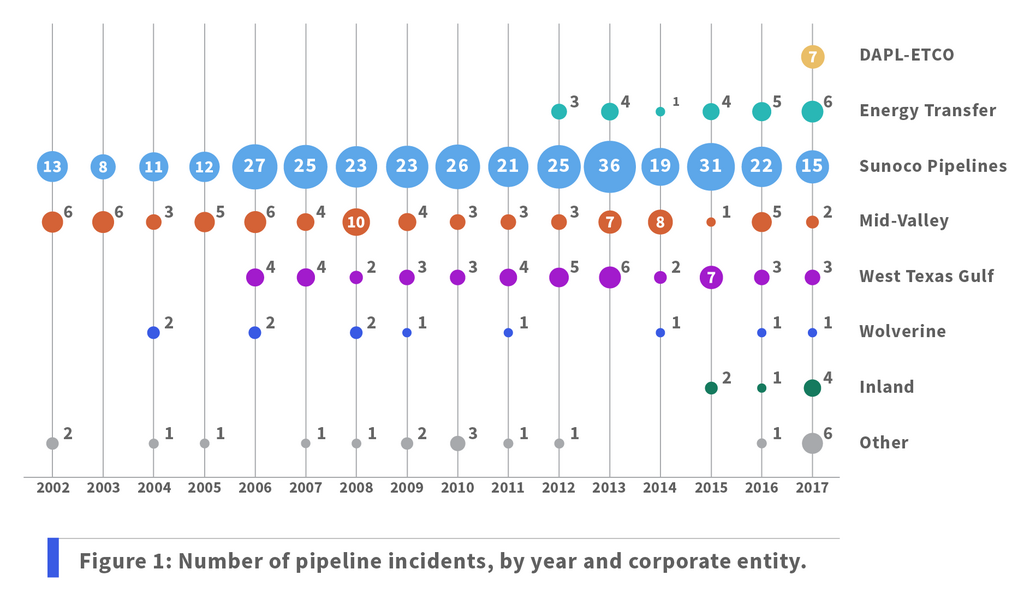
Energy Transfer has reported 23 hazardous liquids incidents, all occurring after the 2012 merger. The Dakota Access Pipeline (DAPL) and its southern component (ETCO) only began operations in 2017, but have already reported 7 incidents. For full details on the incident analysis, including more information on the subsidiaries and joint ventures that were included, see Appendix A: Research Methods.
The ten largest incidents in this analysis are the following (in chronological order):
- In January 2005, the Mid-Valley Pipeline (originally constructed in the 1950s[20]) spilled 6,909 barrels (290,000 gallons) of crude oil into the Kentucky and Ohio Rivers, leading to an oil slick 17 miles long and harming hundreds of migratory birds. The federal government later reached a $2.57 million settlement with Sunoco.[21]
- In November 2005, operator error led to a 10,380 barrel (436,000 gallon) crude oil overflow at Sunoco Pipeline LP’s Darby Creek Tank Farm in Sharon Hill, Pennsylvania. The spilled oil was contained by a dike, and PHMSA later fined Sunoco $150,000.[22]
- In October 2008, the Mid-Valley Pipeline spilled again, this time releasing 3,650 barrels (153,000 gallons) into “the sanitary sewer system and nearby Gunpowder Creek” in Florence, Kentucky.[23]
- In June 2009, a portion of the West Texas Gulf Pipeline near Colorado City, Texas caught fire and spilled 3,416 barrels (143,000 gallons) of crude oil. PHMSA later fined Sunoco Pipeline LP $415,000.[24]
- In August 2009, Sunoco Pipelines spilled 2,500 barrels (105,000 gallons) of crude from a station near Mont Belvieu, Texas. The U.S. EPA eventually reached a $850,000 settlement for Clean Water Act violations related to this spill and a later 2011 spill of 1,742 barrels (73,000 gallons) in Cromwell, Oklahoma.[25]
- In October 2014, the Mid-Valley Pipeline experienced yet another major incident, spilling 4,509 barrels (189,000 gallons) and contaminating a ten-mile section of Tete Bayou near Mooringsport, Louisiana.[26]
- In June 2015, a “gasket failure” on the West Texas Gulf Pipeline near Wortham, Texas led to a release of 3,300 barrels (139,000 gallons) of crude that was contained in two retention ponds on company property.
- In August and September 2016, Sunoco’s Permian II Express pipeline leaked 8,600 barrels (361,000 gallons) near Sweetwater, Texas. The incident led to a Corrective Action Order, and followed a fine from federal regulators for welding violations on the same project.[27]
- In addition to crude oil spills, ETP pipelines suffered large spills of highly-volatile liquids (HVL)[28] of 2,880 barrels (121,000 gallons) in 2012 near Midland, Texas and 3,992 barrels (168,000 gallons) in 2014 near Ira, Texas.
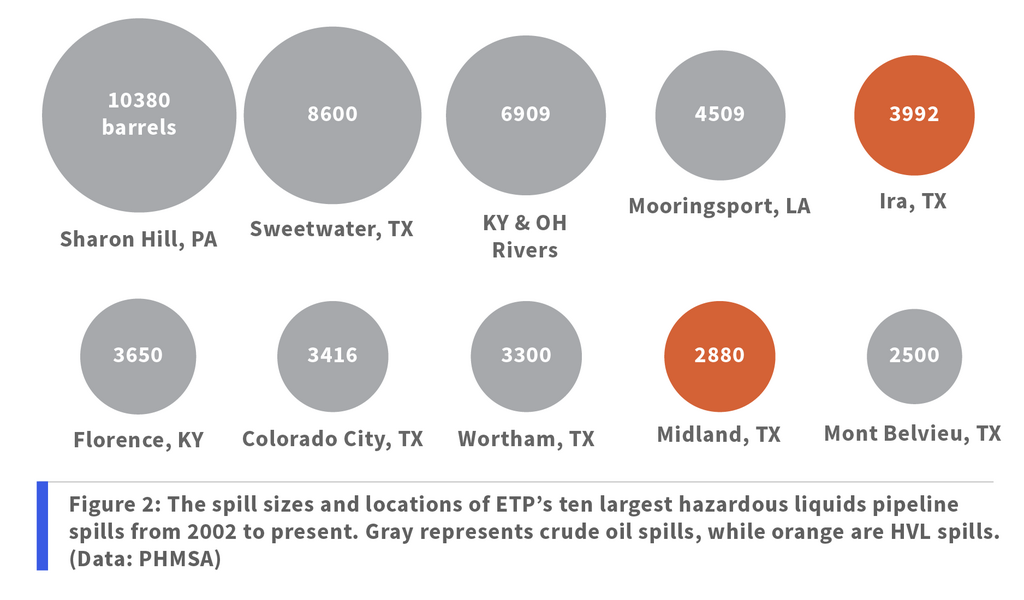
Further details on other ETP/Sunoco pipeline incidents can be found in a report by Waterkeeper Alliance, including information on worker lawsuits, failure to report problems, and additional significant pipeline incidents in Pennsylvania, Ohio, and Texas.[29]
Although it is not the main focus on this report, PHMSA also maintains data regarding ruptures and leaks from natural gas gathering, transmission and distribution pipelines. ETP and its subsidiaries reported 58 natural gas incidents to PHMSA from 2002 to present. Natural gas pipeline leaks present a different range of risks from hazardous liquids leaks, including the risk of an explosion. Methane leaking from the U.S.’s rapidly growing natural gas infrastructure is also a significant climate change risk.[30]
Dakota Access Pipeline and Bakken Project
The Bakken Pipeline consists of the 1,172 mile, 30-inch diameter Dakota Access Pipeline (DAPL), which runs from the Bakken oil fields in North Dakota to a hub in Patoka, Illinois, and the Energy Transfer Crude Oil Pipeline (ETCO), which runs 743 miles south from Patoka to Nederland, Texas.[31] The DAPL segment was built across Sioux lands designated under the 1851 Fort Laramie Treaty and crosses the Missouri River near Lake Oahe, just north of the Standing Rock Reservation.[32] The project is a joint venture between ETP, MarEn Bakken Company LLC (Enbridge) and Phillips 66, with ETP holding a 38.25% interest.
Violations of Indigenous sovereignty, lack of adequate consultation and threats to water supplies from pipeline spills led Indigenous Water Protectors and their allies to set-up pipeline opposition camps near the river crossing. The organized pipeline opposition and the disproportional response from authorities and private security forces garnered international media attention, leading the Army Corps of Engineers to deny the needed permits in December 2016. However, the Trump Administration approved the permits and DAPL went into operation in June 2017.
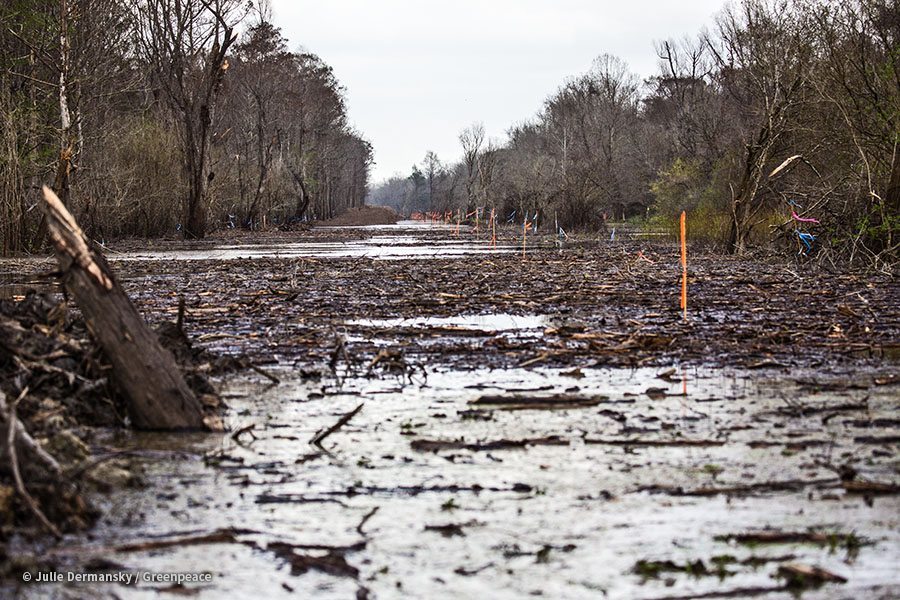
Evidence suggests that environmental racism may have played a part in selecting the pipeline route. The 2015 Environmental Assessment discussed an alternate route that was rejected in part due to concerns about contamination of “wellhead sourcewater protection areas” north of Bismarck, North Dakota (a mostly white community).[33] Yet the approval of the route passing near the reservation led the Standing Rock Sioux Tribe to file a lawsuit alleging violations of the National Historic Preservation Act, the Clean Water Act, and the National Environmental Policy Act.[34]
In addition to the risk of pipeline spills into water, the EA identified impacts from horizontal directional drilling (HDD) used to tunnel the pipeline under rivers, including the risk of “inadvertent release of drilling fluid directly or indirectly into the waterbody” — a risk that has been realized during the construction phases of other ETP/Sunoco projects.
Although the pipeline only became fully operational in 2017, DAPL-ETCO has already reported 7 pipeline incidents to PHMSA, of which 4 occurred along the DAPL portion, and the largest of which was a significant 119 barrel (4,998 gallon) spill from the ETCO segment near Dyersburg, Tennessee. A related eighth incident occurred in March 2017 on a DAPL feeder line owned by Caliber Midstream, but is not included in this analysis.[35]
Assuming the U.S. system-wide rate for significant crude oil spills of 0.001 per year per mile, we estimate that the Bakken Pipeline would suffer 96 significant spills during a 50-year nominal lifetime.
Federal violations and fines
PHMSA conducts annual inspections to determine whether pipeline operators are in compliance with federal rules designed to protect the public, drinking water sources and ensure safe operation of pipelines and their associated infrastructure. These routine inspections find violations that could lead to a spill or a safety problem. When federal inspectors find serious issues, they issue Notices of Proposed Violations, Proposed Compliance Orders and/or Proposed Civil Penalties. Since 2002, PHMSA has issued Energy Transfer Partners and Sunoco 106 violations and fined them $5,675,870.[36] Their safety violations include:
- Failures to inspect crossings under waterways, valves and pipeline rights of way.
- Failures to notify PHMSA of a spill, fire, injuries requiring hospitalization.
- Failure to repair unsafe pipe for 5 years.
- Failures to maintain pipeline integrity in high consequence areas.
- Failure to report unsafe conditions.
- Failure to do corrosion inspection.
- Repeated failures to properly notify emergency responders and the public.[37]
Consequences of pipeline spills
Depending on their characteristics, oil spills can cause significant acute and chronic impacts on ecosystems ranging over “a range of time scales, from days to years, or even decades for certain spills.”[38] PHMSA collects information on whether pipeline spills have contaminated soil or water resources, impacted wildlife, or occurred in “high-consequence areas” (HCAs) such as population centers or navigable waterways (see Figure 3).
Of the 527 incidents attributed to ETP, Sunoco, their subsidiaries or joint ventures:
- 67 incidents (12.7%) were reported to have contaminated water resources. Across the entire PHMSA database, 615 incidents (10.0%) contaminated water resources.
- Of those incidents, 18 incidents (3.4%) were found to contaminate groundwater. Nationally, there were 207 pipeline spills contaminating groundwater (3.4%).
- And 3 incidents (0.6%) were found to contaminate drinking water resources specifically. Nationally, there were 8 total incidents (0.1%) contaminating drinking water.
- 275 incidents (52.5%) contaminated soils.
- 189 incidents occurred in or reached “high consequence areas.”
- From 2010-present, there were 6 incidents that impacted wildlife. One of these was a spill of 450 barrels in March 2014, from the Mid-Valley Pipeline, that contaminated the Oak Glen Nature Preserve near Colerain, Ohio,[39] closing the preserve and leaving at least 36 animals in need of treatment for contamination.[40]
- From 2002 to 2009, there were 3 incidents that impacted fish and 2 incidents that impacted birds.
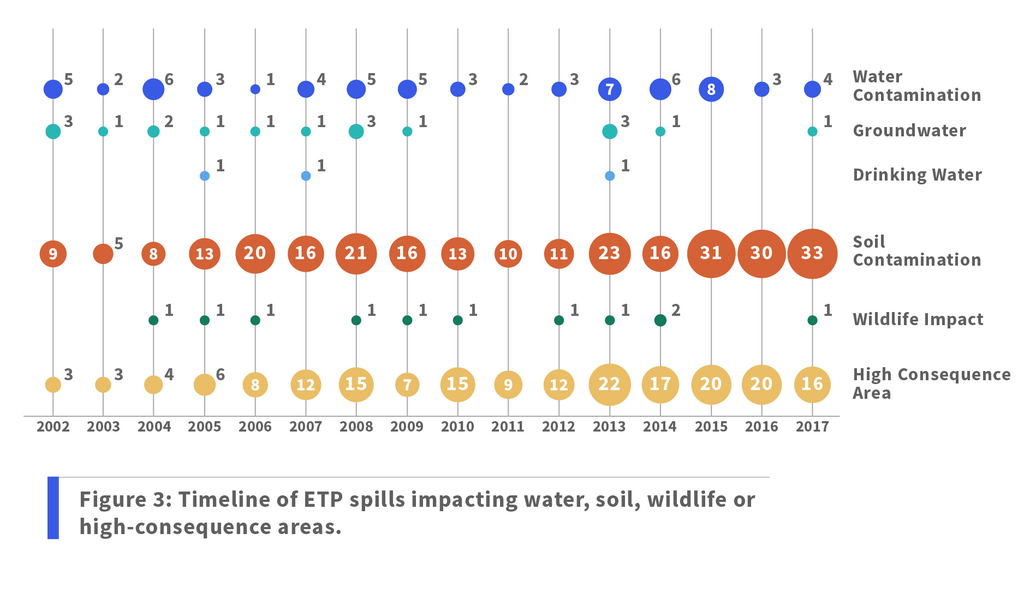
A 2010 editorial from a Philadelphia-area newspaper lamented the consequences of Sunoco’s local safety record and noted that repeated violations “will only be stopped when the nation’s environmental protection laws finally grow some teeth. In the meantime, Delaware County residents must be satisfied with apologies and the prospect of ill health or injury from another industrial disaster.”[41]
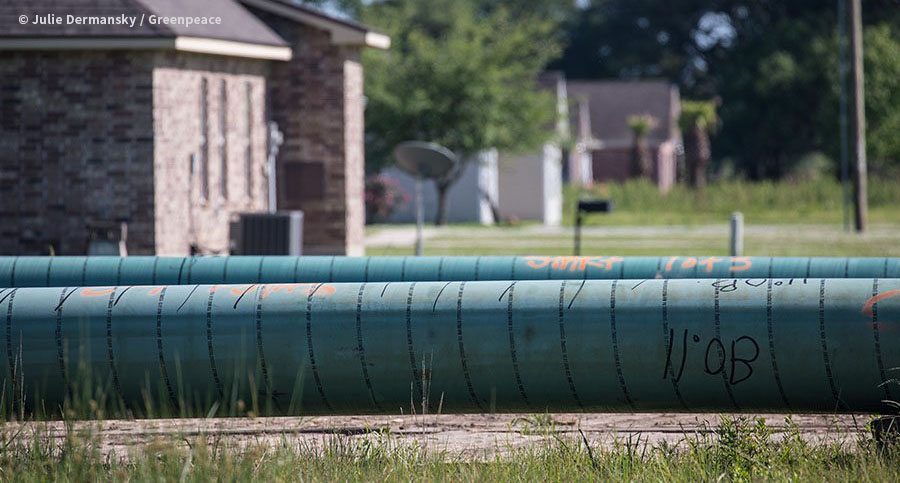
Energy Transfer Partners and Sunoco spills, fines, and stop work orders during construction
In addition to past spills from existing pipelines, ETP/Sunoco pipeline projects currently under development have been plagued with environmental violations. The construction of the Mariner and Rover pipelines in Michigan, Ohio, Pennsylvania and West Virginia has resulted in over 2.4 million gallons of spills, over 100 notices of violations and other non-compliance issues, and 6 stop work orders. These new pipelines have faced growing resistance from local communities and decision makers concerned about the long history of non-compliance and pollution of drinking water sources, trout streams, wetlands and rivers.
Rover
ETP’s Rover Pipeline is a 713-mile natural gas pipeline designed to transport 3.25 billion cubic feet of gas per day from the Utica and Marcellus shale production areas in West Virginia, eastern Ohio, and western Pennsylvania westward through Ohio and into Michigan.[42] In an ominous foreshadowing, ETP started getting into trouble before construction even started. Despite promising to “avoid adverse effects,” ETP destroyed the historic 170-year old Stoneman House in Dennison, Ohio that was eligible for listing in the National List of Historic places. The Federal Energy Regulatory Commission used the demolition of the historically significant site as a basis for denying Rover a blanket construction permit, saying “Rover could not be relied upon to comply with the environmental regulations.”[43]
With that restriction, FERC approved the project in February 2017, and Energy Transfer began an aggressive effort to construct the pipeline as quickly as possible. In its haste, ETP repeatedly contaminated waterways across Michigan, Ohio and West Virginia. One August 2017 analysis concluded that Rover had “racked up more environmental violations than other major interstate natural gas pipelines built in the last two years” – a total of 104 non-compliance incidents while the second highest company only had 26 non-compliance incidents.[44]
By March 2018, after only 13 months of construction, Rover had spilled more than 2.2 million gallons of drilling fluids, industrial waste and/or sediment, amassing more than 100 violations/non-compliance incidents and 4 stop work orders for their failure to comply with environmental regulations designed to protect streams, rivers wetlands, drinking water, historic sites and public safety (see BOX below for a selection of these violations, citations for these incidents are listed in Appendix C).

Worst Rover pipeline violations/spills/stop work orders April 2017-March 2018
- April 5, 2017: unauthorized pollution release impacting tributaries of Woodfield Reservoir in Monroe County, OH; failure to control stormwater
- April 8, 2017: 1,000 gallons of drilling fluid pollution released into wetland near Indian Fork River, in Tuscarawas County, OH; covered 2500 square foot area of wetland
- April 10, 2017: 600 gallons of drilling fluid pollution released into stream, wetland and pond in Richland Township, Belmont County, OH
- April 10, 2017: unauthorized pollution release impacting tributaries of Woodfield Reservoir in Monroe County, OH; failure to control stormwater
- April 11, 2017: unauthorized pollution release from failure to manage stormwater in Bloomdale, Wood County, OH
- April 11, 2017: Clean Air Act violation, open burning of site preparation material near a home in Toronto, Ohio
- April 11, 2017: Stormwater violations in Wood, Richland, and Crawford Counties, OH because of failure to manage vehicle tracking of drilling materials onto public roadways
- April 12, 2017: unauthorized pollution release into Bull Creek in Wood County, OH; failure to control stormwater
- April 13, 2017: 2 million gallons of drilling fluid pollution accumulating in high quality wetland adjacent to Tuscarawas River in Navarre Township, Stark County; covered 500,000 sq foot area of the category 3 wetland
- April 14, 2017: 50,000 gallons of drilling fluid pollution released into wetland in Mifflin Township, Richland County, OH
- April 17, 2017: 200 gallons of drilling fluid pollution released into a pond in Monroe Township, Harrison County, OH
- April 22, 2017: 200 gallons of drilling fluid pollution released into stream in Wooster Township, Wayne County, OH
- April 26, 2017: During a West Virginia DEP inspection, 7 violations are found related to Storm Water Pollution Prevention Plan (SWPPP) and stream sediment deposits.
- May 2, 2017: unauthorized pollution release from failure to manage stormwater in Bloomdale, Wood County, OH
- May 3, 2017: unauthorized pollution release into Brushy Fork Creek, Cadiz, Harrison County, OH – failure to control stormwater
- May 8, 2017: approx. 10,000 gallons of bentonite slurry released during a pipeline installation. The drilling fluids surfaced in a pond and stream in Monroe Township, Harrison County and affected water quality.
- May 8, 2017: The Ohio EPA fines ETP $431,000 for “18 incidents involving mud spills from drilling, stormwater pollution and open burning at Rover pipeline construction sites have been reported between late March and Monday.”
- May 10, 2017: FERC bans ETP from starting new horizontal directional drilling under waterways and roads.
- May 19, 2017: ETP acknowledges heavy rain causing pipeline trenches and work spaces to fill with water and spill onto fields of Ohio farmers.
- May 24, 2017: During a West Virginia DEP inspection, 6 violations are found related to Storm Water Pollution Prevention Plan (SWPPP), erosion control and stream sediment deposits.
- May 25, 2017: FERC rejects ETP request to resume drilling in Captina Creek and Middle Island Creek.
- June 2 & 6, 2017: During a West Virginia DEP inspection, 5 violations are found related to silt fences, erosion control and stream sediment deposits.
- July 2, 2017: 5,000 more gallons of drill slurry released into a Stark County area where the company was working on a five-foot borehole that would go under the Tuscarawas River. Work was already underway to deal with a previous spill in that area.
- July 3, 2017: 1,500 to 2,500 gallons of drilling mud took place at a nearby area ten feet from Tuscarawas River.
- July 7, 2017: Rover Pipeline LLC pays $1.5 million to the Ohio History Connection Foundation in an effort to mitigate harm after demolishing a building they had promised not to.
- July 12, 2017: During a West Virginia DEP inspection, 8 violations are found including sediment laden water depositing in nearby creeks and runs.
- July 13, 2017: FERC also issues a notice of violation claiming that ETP “did not fully and forthrightly disclose all relevant information” before demolishing a historic home.
- July 17, 2017: West Virginia’s DEP issues a cease-and-desist order to stop work in the WV segment of the pipeline.
- July 28, 2017: Pipeline drilling causes landslides in Jefferson County, Ohio. According to township trustees, it’s a result of drilling near old underground mines.
- July 31, 2017: Inspectors find failure to properly control erosion and incorrectly-installed sediment control devices in Hancock County, WV.
- August 3, 2017: Inspectors find failure to properly control erosion and incorrectly-installed sediment control devices in Marshall County, WV.
- September 21, 2017: Soap wastewater used in boring operations and soil/sediment discharged into approximately 500 feet of waterway requiring 6,000 gallons of water to be recovered by vacuum truck. OH
- September 26, 2017: Approximately 30 gallons of drilling fluids discharged into waters, wetlands in Washington Township, Belmont County, Ohio.
- October 11, 2017: Approx. 1200 gallons of drilling fluids discharged to waters, wetlands in Washington Township, Belmont County, Ohio.
- October 14, 2017: Rover Pipeline Spills Water Allegedly Containing Gasoline Into Michigan Wetlands
- November 9, 2017: Approx. 60 gallons of drilling fluids discharged to waters, wetlands in Ashland Township, Ashland County.
- November 14, 2017: Approx. 30 gallons of drilling fluids discharged to waters, wetlands in Milton Township, Ashland County, Ohio.
- November 16, 2017: Approx. 200 gallons of drilling fluids discharged into Black Fork Mohican River in Milton Township, Ashland County.
- January 17, 2018: Rover Pipeline Spills Another 150,000 Gallons of Drilling Fluid Into Ohio Wetlands at same 4/14/2017 site.
- January 24, 2018: FERC again orders ETP to halt horizontal directional drilling under the Tuscarawas River in Ohio.
- February 21, 2018: Ohio EPA files a letter with FERC claiming the presence of toxic chemical tetrachloroethene at Rover’s underground drilling site at the Tuscarawas River in southern Stark County.
- March 5, 2018: West Virginia Department of Environmental Protection orders a second halt to construction after finding multiple water pollution violations.
Mariner
The Mariner East Project is designed to transport natural gas liquids from the same Utica and Marcellus shale production areas, this time eastward across Pennsylvania, including to the Marcus Hook terminal on the Delaware River.[45] The first phase of the Mariner project began operations in 2014, while Mariner East 2 is scheduled to be completed in 2018. Construction of the pipeline has led to 108 “inadvertent” releases in numerous locations along the route, leading the Pennsylvania DEP to issue more than 40 violations,[46] and several reports of private water wells being impacted by construction activities.[47] Those spills have released a total of at least 200,000 gallons of drilling fluids and other liquids.[48] The Mariner 1 and Mariner 2 pipelines have been shut down twice as a result of spills, violations, sink holes and contamination of drinking water and trout streams.
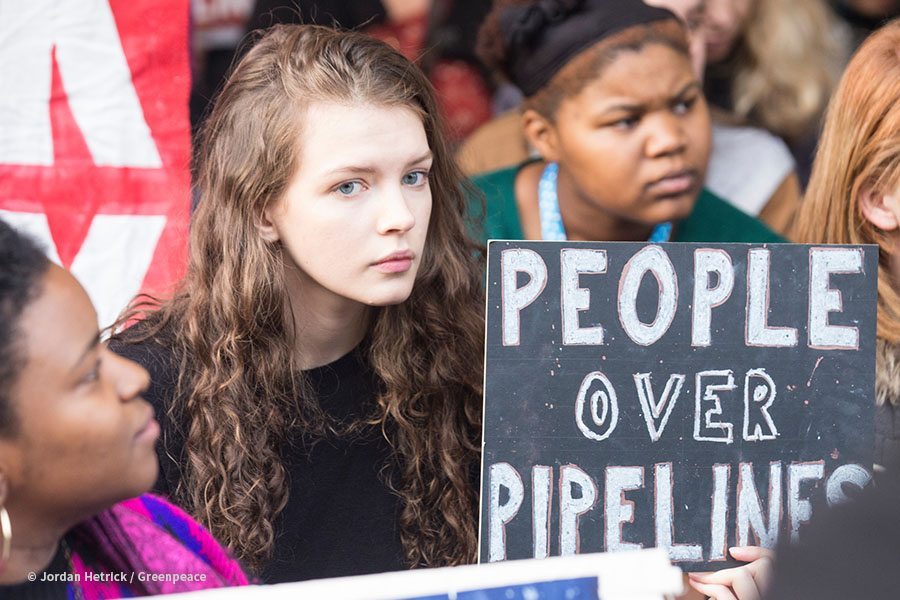
The Pennsylvania DEP Administrative Order shutting down construction on January 3, 2018 itemized unpermitted and unlawful activities impacting the following trout streams classified as Class A wild trout waters, wild trout (natural reproduction) water, high quality trout stocking and designated as exceptional value waters and/or migratory fishes:
- Hay Creek in Berks County
- Cacoosing Creek in Berks County
- Allegheny Creek in Berks County
- Clover Creek in Blair County
- Mingo Creek in Washington County
- Shaeffer Creek in Dauphin County
The 24-page order also required Sunoco to address the private water wells contaminated in Silver Lake Township “to the satisfaction of the private well owners.” The order concluded by saying:
“Sunoco’s unlawful conduct… demonstrates a lack of ability or intention on the part of Sunoco to comply with the Clean Streams Law, the Dam Safety and Encroachments Act, and the permits issued thereunder. Suspension of the permits… is necessary to correct the egregious and willful violations described herein.”[49]
On February 8, 2018 the Pennsylvania DEP and Sunoco executed a Consent Order and Agreement requiring the payment of a $12.6 million penalty and that Sunoco provide detailed plans to prevent future violations.[50] It was one of the largest fines ever levied by the State of Pennsylvania for violations of environmental laws.
Less than 30 days later, Mariner was shut down again in Pennsylvania due to problems during construction. On March 7, 2018, the Pennsylvania Public Utility Commission (PUC) issued an emergency order shutting down the Mariner 1 pipeline during construction of the adjacent Mariner 2 pipeline.[51] The emergency order said that allowing the continued transport of hazardous liquids through the Mariner 1 pipeline “could have catastrophic results impacting the public.”[52] The PUC estimated the pipeline would be shut down 10-14 days, possibly longer if ETP/Sunoco failed to address serious safety concerns that the pipeline could be “hazardous to life, property and the environment.”[53] Among the safety issues that triggered the rare emergency shut down were the formation of three large sinkholes in a densely populated area defined by PHMSA as a “high consequence area”. One sinkhole was located 300 feet from rail lines carrying Amtrak and Septa passengers. Another sink hole was created 10 feet from the foundation of a house.
U.S. pipeline spill trends
Over the past several years, spills of crude oil and liquid petroleum products from pipelines have increased, reversing earlier improvements.[54] This trend reached its maximum in 2015 with a total of 454 reported incidents, of which 176 were classified as significant by PHMSA. These numbers dropped slightly in 2017 to 404 reported incidents (153 significant) but remained at an elevated level compared to earlier years (see Figure 4).
Similarly, a recent review by oil industry trade organizations found that pipeline incidents “impacting the public or environment” (IPE) have increased in the past 4 years.[55]
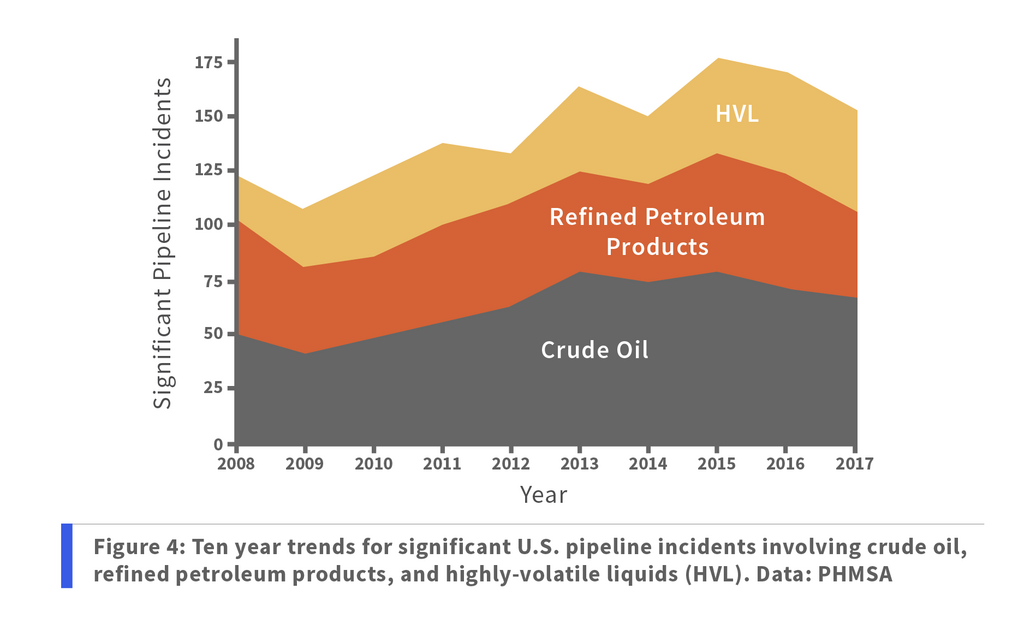
The key takeaway from these statistics is that despite industry rhetoric to the contrary, there is no failsafe way to transport fossil fuels. Industry safety initiatives and an overmatched regulatory agency have been unable to eliminate the risk of spills, which remain a direct and seemingly unavoidable consequence of oil and gas activity. PHMSA employs a mere 208 inspectors who, along with 345 state inspectors, are responsible “for regulating nearly 3,000 companies that operate 2.7 million miles of pipelines, 148 liquefied natural gas plants, and 7,571 hazardous liquid breakout tanks.”[56] The oil industry also has one of the highest rates of severe workplace injury among its workers.[57]
Over the past decade, hazardous liquid pipeline spills in the U.S. have led to 16 fatalities, 30 injuries, $2.7 billion in costs, and over 825,000 total barrels spilled (34.7 million gallons, or around 9,500 gallons every day).[58] Common causes of pipeline spills include equipment failures, corrosion, operator error, material or welding failures, and excavation damage.[59]
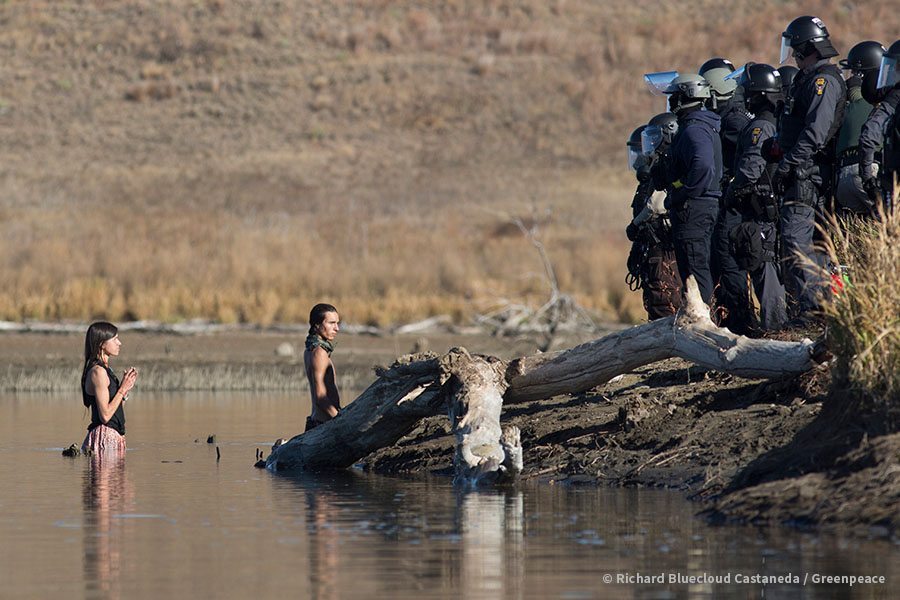
Significant pipeline spills in recent years include Enbridge’s 2010 spill into the Kalamazoo River,[60] Exxon’s 2013 Pegasus pipeline spill in Mayflower, Arkansas, two spills into the Yellowstone River in 2011 and 2015,[61] and the 2015 pipeline rupture that closed a Santa Barbara beach.
These pipeline spills are in addition to spills from oil wells, disposal sites, and other oil and gas infrastructure, both onshore and offshore.[62] Of total spills from all sources in 2015, a recent analysis found that 640 spills affected groundwater or surface water in some way.[63]
From 2007 to 2016, U.S. crude oil pipelines have averaged 0.001 significant incidents and 0.57 barrels spilled per year per mile of pipeline. Refined petroleum product pipelines have averaged 0.0007 significant incidents and 0.24 barrels spilled per year per mile, and HVL pipelines have averaged 0.0005 significant incidents and 0.53 barrels spilled per year per mile.
Future threats to water
Bayou Bridge Pipeline
Oil and pipeline companies have devastated the Gulf coast and the Atchafalaya Basin, harming some of the most amazing ecosystems on Earth, putting millions of people at greater risk of flooding.[64] The Bayou Bridge pipeline is a great example of what is wrong with pipeline construction in Louisiana. It will traverse over, under or through the Calcasieu River, Mermentau River, Vermilion River, Bayou Teche, West Atchafalaya Basin Levee, Atchafalaya River Basin and multiple bayous that provide unique habitat for many rare species. There is pending litigation arguing that the existing corridor being used to place the Bayou Bridge Pipeline is already out-of-compliance with permits issued for prior pipeline projects. In the same litigation, opponents argue that another existing pipeline in the Atchafalaya Basin co-owned by Energy Transfer Partners is also out of compliance with a previously-issued permit.[65] Disposal of dredged material during the construction of these earlier pipelines led to the creation of spoil banks which have been found to cause serious disturbances of water flow and impact the distribution of sediments in the Basin.[66] Historically there has been little enforcement of permit violations.[67]
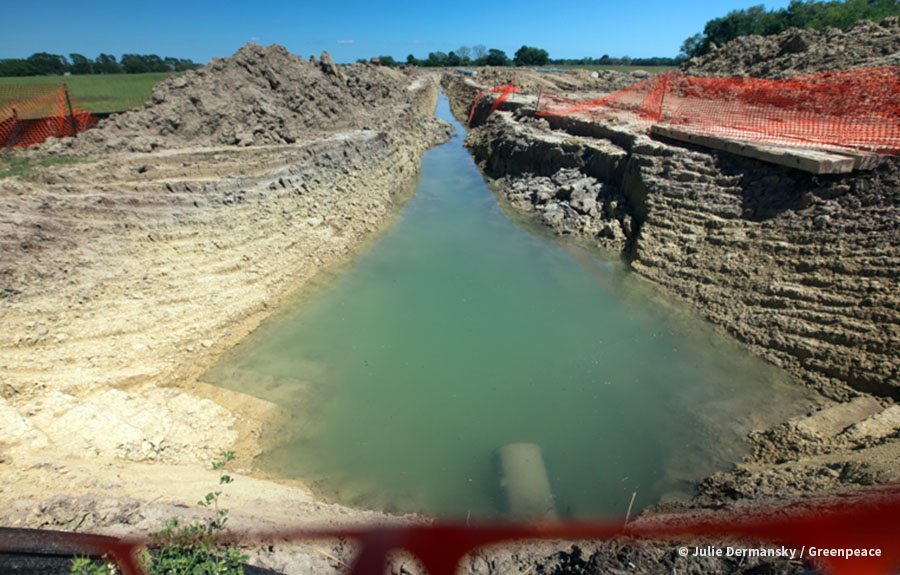
The Bayou Bridge pipeline is a joint venture between ETP and Phillips 66[68] (two of the participants in DAPL) that will transport up to 480,000 barrels of crude oil a day across Louisiana, from Nederland, Texas (the southern terminus of the Bakken pipeline) to refineries in St. James, Louisiana (about 50 miles up the Mississippi River from New Orleans).[69] Phase I of the Bayou Bridge Pipeline, from Nederland, Texas to Lake Charles, Louisiana, is already operational. However, Phase II, the proposed 163-mile portion from Lake Charles to St. James, is under construction and multiple lawsuits have been filed to challenge the permits issued in 2017.[70]
As detailed in a U.S. Army Corps of Engineers Environmental Assessment, Bayou Bridge Pipeline LLC plans to use horizontal directional drilling (HDD) to run pipe under 8 federal projects and 14 federal easements (mostly crossings of rivers, waterways and levees).[71] As is typical, PHMSA conducted a “worst case” analysis for spills occurring at those crossings, but details of that analysis have not been made public.
Analysis by FracTracker Alliance found that the pipeline would cross “700 acres of fragile wetlands, and watersheds that supply drinking water for up to 300,000 people” and noted that “essential ecosystem services that the wetlands provide, absorbing floodwaters, could be compromised, leading to increased erosion and sedimentation downstream. Impacts to these wetlands could be greatly magnified into the already environmentally stressed Gulf.”[72]
Assuming the U.S. system-wide rate for significant crude oil spills of 0.001 per year per mile, we estimate that the Bayou Bridge Pipeline would suffer eight significant spills during a 50-year nominal lifetime. In February 2018, a federal court issued an injunction stopping construction while the court considers environmental challenges to the project.[73] But that injunction was stayed by the 5th Circuit Court of Appeals in March with an expedited hearing on the injunction appeal scheduled before a merits panel on April 30, 2018.[74]
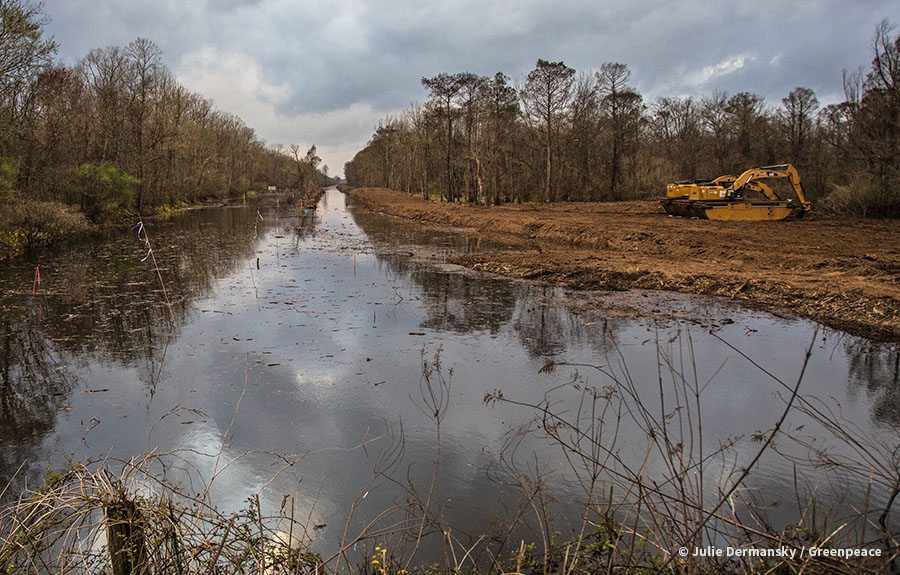
Bayou Bridge Pipeline began clearing for construction in the Atchafalaya Basin in January 2018.[75] Despite the elevated annual rise of water in the Basin, Bayou Bridge intends to continue construction in the Basin during high water season.[76] Construction during high water could exacerbate the damage to wetlands, channeling sediment-laden water into the interior swamps through pipeline canals, causing increased sedimentation and filling of wetlands which reduce their future capability to protect millions of people from Mississippi River floods.[77]
Permian Express
In late 2017, ETP brought its Permian Express 3 pipeline online, transporting crude oil from the Permian basin (a major oil and gas producing basin located in West Texas and parts of New Mexico) to facilities in Nederland, Texas, and is “aggressively” evaluating a further expansion of that line.[78]
Acknowledgements
- Rainforest Action Network
- Earthworks
- Big Bend Defense Coalition of West Texas
- Thunder Valley Community Development Corporation
- 350.org New Orleans
- Pipeline Safety Coalition
- Seeding Sovereignty
- Michigan Residents Against ET Rover
- HELP Association of Saint James
- West Virginia Headwaters Waterkeeper
- Indigenous Peoples Power Project
- International Indigenous Youth Council
Endnotes
1. Interactive map shows a total of 517 incidents due to 10 incidents in the PHMSA data with missing or unusable geolocation data. Shapefiles of the U.S. crude oil, petroleum product, and natural gas liquids pipeline network are compiled by the U.S. Energy Information Administration (EIA) [link].
2. Energy Transfer. Ownership Overview. [link]
3. Hampton, L. & V. Volcovici. 2016. Top executive behind Dakota Access has donated more than $100,000 to Trump. Reuters, October 26. [link]
4. Cama, T. 2017. Energy companies donated millions to Trump’s inauguration. The Hill, April 19. [link]
5. Memorandum of January 24, 2017. Construction of the Dakota Access Pipeline. 82 FR 11129. [link]
6. Energy Transfer. Recent History. [link]
7. Energy Transfer. 2012. Energy Transfer Partners and Sunoco Announce Successful Completion of Merger. October 5. [link]
8. Sunoco. About Us: A Legacy of Innovation. [link]
9. Energy Transfer. 2012. Energy Transfer Partners to Acquire Sunoco in $5.3 Billion Transaction. April 30. [link]
10. Energy Transfer. 2017. Sunoco Logistics Partners and Energy Transfer Partners Announce Successful Completion of Merger. April 28. [link]
11. Energy Transfer. Corporate Overview. [link]
12. This quantity excludes a small number of biofuels and CO2 incidents. For this report we consider hazardous liquids spills from crude oil, refined petroleum products, and HVL pipelines. PHMSA reporting requirements changed in 2010, and this analysis merges PHMSA’s 2002-2009 and 2010-present datasets.
13. ETP or Sunoco must hold at least a 25% stake in a joint venture for it to be included in this analysis.
14. see Appendix B.
15. Waterkeeper Alliance. 2017. Sunoco Logistics and Energy Transfer Partners Pipeline Incident Summary. [link]
16. National Wildlife Federation. 2010. Assault on America: A Decade of Petroleum Company Disaster, Pollution, and Profit. [link]
17. Hampton, L. 2016. Sunoco, behind protested Dakota pipeline, tops U.S. crude spill charts. Reuters, September 23. [link]
18. Higgins, T. 2017. Energy Transfer’s Pipeline Spill Problem Is Causing It Another Headache. The Street, June 22. [link]
19. U.S. Department of Justice. 2005. United States Announces Clean Air Agreements With Valero and Sunoco. June 16. [link]
20. Welborn, V. 2014. Pipeline breaks have cost Sunoco millions. Shreveport Times, November 1. [link]
21. U.S. Department of Justice. 2006. Federal Government Reaches Settlement with Pipeline Companies Regarding Crude Oil Spills. August 15. [link]
22. U.S. Department of Transportation, Pipeline and Hazardous Materials Safety Administration. 2007. Notice of Probable Violation and Proposed Civil Penalty. May 15. [link]
23. U.S. Department of Transportation, Pipeline and Hazardous Materials Safety Administration. 2014. Corrective Action Order. March 25. p.3. [link]
24. U.S. Department of Transportation, Pipeline and Hazardous Materials Safety Administration. 2010. Notice of Probable Violation, Proposed Civil Penalty and Proposed Compliance Order. March 11. [link]
25. U.S. Environmental Protection Agency. 2016. Sunoco Pipeline, L.P. Clean Water Act Settlement. July 11. [link]
26. U.S. Environmental Protection Agency. E15601 – Mid Valley Pipeline Oil Spill. [link]
27. Reuters Staff. 2016. U.S. regulator orders inquiry, repairs after Sunoco’s Permian leak. Reuters, September 15. [link]
28. PHMSA classifies together highly-volatile liquids (HVL) or other flammable or toxic fluids which are a gas at ambient conditions (i.e. when spilled). Examples include ethane, propane and butylene.
29. Waterkeeper Alliance 2017.
30. Greenpeace USA. Natural Gas: Methane’s contributions to global warming. [link]
31. Energy Transfer. Bakken. [link]
32. Sack, C. 2016. A #NoDAPL Map. Huffington Post, November 2. [link]
33. Dakota Access LLC. 2015. Draft Environmental Assessment Dakota Access Pipeline Project Crossings of Flowage Easements and Federal Lands. November. [link]
34. Earthjustice. Updates & Frequently Asked Questions: The Standing Rock Sioux Tribe’s Litigation on the Dakota Access Pipeline. [link]
35. Brown, A. 2018. Five Spills, Six Months in Operation: Dakota Access Track Record Highlights Unavoidable Reality — Pipelines Leak. The Intercept, January 9. [link]
36. see Appendix B
37. Ibid.
38. Ramseur, J. 2017. Oil Spills: Background and Governance. Congressional Research Service. [link]
39. Perry, K. 2015. 2014 oil spill still mars nature preserve. Cincinnati.com, May 16. [link]
40. PHMSA 2014.
41. Delaware County Daily Times. 2010. Editorial: Penalty for Sunoco has a foul smell. January 6. [link]. Quoted in NWF 2010.
42. Rover Pipeline. The Facts on Rover Pipeline Project. [link]
43. FERC. 2017. Order On Clarification and Denying Rehearing. November 3. [link]
44. Malik, N.S. & C. Traywick. 2017. Blackstone’s New Pipeline Asset Is Wreaking Environmental Havoc, Bloomberg News, August 17. [link]
45. Sunoco Pipeline. Mariner East. [link]
46. Reuters Staff. 2018. ETP Mariner East liquids pipe spills more fluid in Pennsylvania. Reuters, March 27. [link]; see also Pennsylvania DEP. Pennsylvania Pipeline Portal: Mariner East Pipeline II [link]
47. Hurdle, J. 2017. Water problems persist along Mariner East pipeline route despite court intervention. State Impact (NPR). October 12. [link]
48. Jalbert, K. 2017. Mariner East 2 Drilling Fluid Spills – Updated Map and Analysis. FracTracker, July 26. [link]; see also Pennsylvania DEP. 2018. Sunoco Mariner East II – Pipeline Construction Inadvertent Returns – Waters of the Commonwealth. Revised on March 30, 2018. [link]
49. Pennsylvania DEP. 2018. Administrative Order. January 3. [link]
50. Cusick, M. 2018. Sunoco to resume work, pay $12.6 million for Mariner East 2 pipeline violations. State Impact (NPR), February 8. [link]
51. Pennsylvania PUC. 2018. Emergency Order. March 7. [link]
52. Pennsylvania PUC. 2018. Petition of the Bureau of Investigation and Enforcement of the Pennsylvania Public Utility Commissions for the Issuance of an Ex Parte Emergency Order. March 7. [link]
53. Ibid.
54. U.S. Pipeline and Hazardous Materials Safety Administration. Pipeline Incident 20 Year Trends. [link]; see also Lee, M. 2016. Number of leaks and spills continued to grow in 2015. EnergyWire, August 22. [link]
55. API & AOPL. 2017. Pipeline Safety Excellence: Performance Report & Strategic Plan 2017-2019. [link]; see also Mandel, J. 2017. Safety incidents on the rise after decade of decline. EnergyWire, April 26. [link]
56. U.S. Pipeline and Hazardous Materials Safety Administration. Inspections Overview. [link]
57. Soraghan, M. 2017. Oil and gas industry leads in severe injuries. EnergyWire. May 2. [link]
58. PHMSA. Pipeline Incident 20 Year Trends.
59. Stover, R. America’s Dangerous Pipelines. Center for Biological Diversity. [link]
60. McGowan, E. & L. Song. 2012. The Dilbit Disaster: Inside The Biggest Oil Spill You’ve Never Heard Of, Part 1. InsideClimate News, June 26. [link]
61. Douglas, E. 2015. Yellowstone Oil Spills Expose Threat to Pipelines Under Rivers Nationwide. InsideClimate News, February 6. [link]
62. There is no comprehensive database of all hazardous material spills in the U.S. with data scattered across numerous federal and state agencies, and lacking consistent reporting rules; see also King, P. & M. Soraghan. 2016. Spills dropped 8% in 2015 as new drilling slowed. EnergyWire, July 21. [link]
63. Soraghan, M. & P. King. 2016. Drilling mishaps damage water in hundreds of cases. EnergyWire, August 8. [link]
64. Louisiana’s Disappearing Wetlands, Louisiana’s Oil, Understanding the Environmental and Economic Impact, southeastern.edu, July 12, 2010 [link]; see also Atchafalaya Basin Floodway System, Louisiana Project, State Master Plan, at 3-2. [link]
65. Permit for Wanda Petroleum, Inc., Aug. 21, 1969; Permit for Sorrento Pipeline Co., Sept. 4, 2001. The Bayou Bridge right-of-way follows a path of these two existing pipelines for which both permits prohibited the miles-long spoil banks that were created during construction and that remain today. Permits for Florida Gas Transmission, Dec. 14, 1962 & Feb. 13, 1963. The permits for this 5,325-mile interstate natural gas pipeline jointly owned by Energy Transfer Partners and Kinder Morgan running from Texas, through the Atchafalaya Basin, to south Florida, require the removal of dredged material that could interfere with navigation; see also Atchafalaya Basinkeeper, et al. 2018. Complaint for Declaratory and Injunctive Relief, at 60. [link]
66. State of Louisiana Department of Natural Resources. 2018. Final Report: Senate Resolution No. 154 of the 2017 Regular Session. January. [link]
67. Riegel, S. 2017. Swamp tale: A landman’s long-running environmental whistleblower suit against the state speaks to larger issues about conflict, controversy and trust in the Atchafalaya Basin. Business Report, March 1. [link]
68. Public Accountability Initiative. 2018. The Power Behind the Pipelines: Bayou Bridge Pipeline. [link]
69. Bayou Bridge Pipeline. Bayou Bridge Facts. [link]
70. Kunzelman, M. 2018. Judge hears testimony in request to halt Bayou Bridge pipeline. Associated Press, February 9. [link]
71. U.S. Army Corp of Engineers. 2017. Environmental Assessment: Section 408 Evaluation of Bayou Bridge Pipeline Project. [link]
72. Fractracker Alliance. 2017. Pipeline Under Debate in Louisiana Bayou. January 3. [link]
73. Gilmer, E. 2018. In rare move, court halts ETP oil pipeline. EnergyWire, February 26. [link]
74. Hardy, S. 2018. Federal Appeals Court lifts stay blocking pipeline construction through Atchafalaya Basin. The Advocate, March 15. [link]
75. Baurick, T. 2018. Bayou Bridge Pipeline’s controversial construction begins. The Times-Picayune, January 29. [link]
76. Bayou Bridge Pipeline, LLC’s Reply in Support of Emergency Motion for Stay Pending Appeal, at 1-2 (discussing water level influence on construction) filed on Mar. 6, 2018, Case No. 18-30257, Fifth Cir. Court of Appeals.
77. Declaration of Dr. Ivor van Heerden, at Paragraph 4.
78. Reuters staff. 2018. ETP eyes new crude pipeline from Permian basin to Nederland, Texas. Reuters, February 22. [link]

